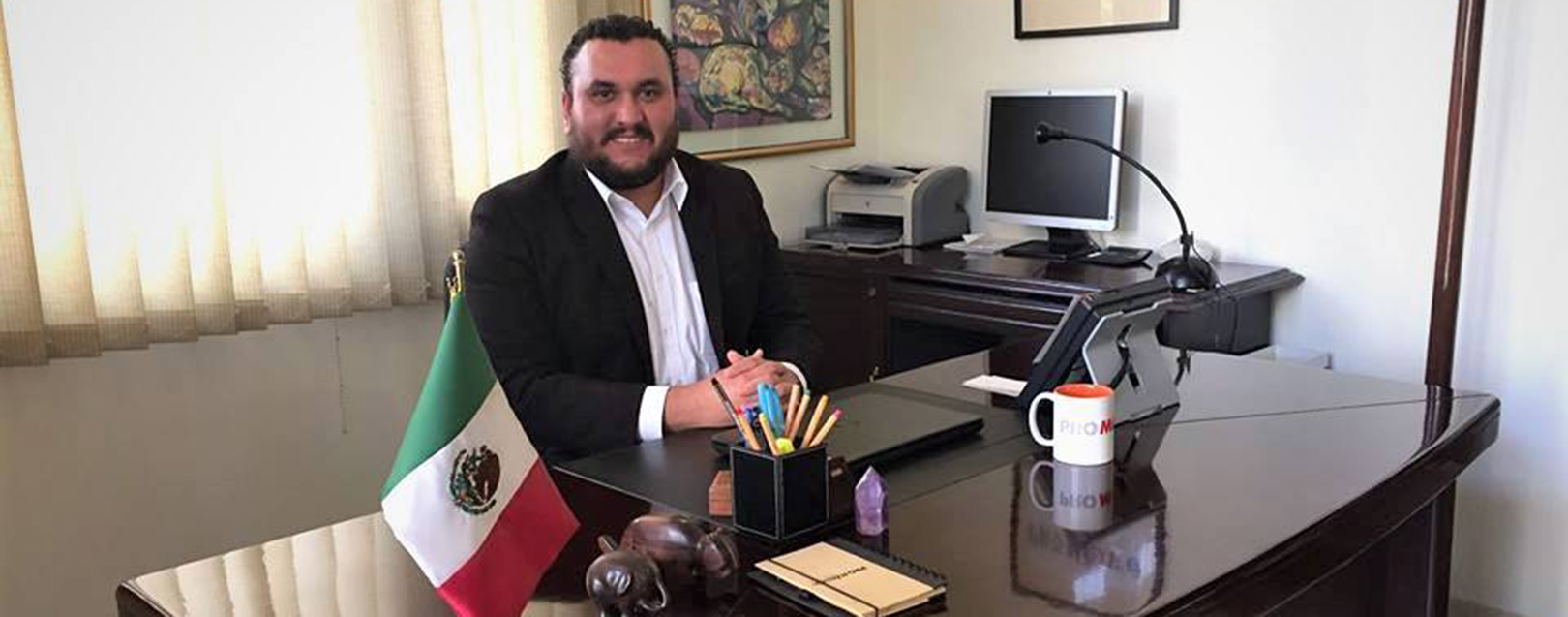
India and Mexico’s bilateral trade could reach $10 bn in 5 years: Blanco
Sheela Mamidenna
Mexico, in her current predicament, has found a new ally and confidante in India. Trump’s bullying tactics and racist remarks have cornered Mexicans and jeopardised their economy. Mexico depends on the US for 81% of its exports and nearly 50% of its imports. However, India's vibrant, growing diverse democratic culture has caught Mexico's fancy. The North American country is aware that in terms of growth rate and increasing population, India is ‘shining and growing’.
Throwing more light on the increasing bilateral trade, investment opportunities, and workforce immigration ties that India and Mexico share on a favourable note, Rodrigo Blanco (RB), Principal Trade & Investment Officer (India, Sri Lanka, Maldives, Bangladesh and Nepal), Mexican Embassy shared his views and thoughts with The Dollar Business (TDB).
TDB: Mexico has been one of the biggest investors in India amongst the Latin American countries. What is it that clicks between the two countries?
RB: Putting this in context, it is important to mention that according to the FDI Report 2016, Mexico accounts for 40% of the total FDI that goes out of LATAM to the World. That is why Mexican companies are not hesitant of investing in relevant markets like India. As of 2016, we have 13 leading Mexican companies such as Cinepolis, Mexichem, Kidzania, Metalsa, Nemak, Grupo Kuo, Katcon etc., which have invested more than $800mn in India. I believe this trend will continue for Mexican companies because they see a lot of promise in India, not only for the current size of its local market and its future growth potential but also for its very competitive labour cost.
Indian Government Programs such as 'Make in India', 'Digital India’, etc. are key initiatives to attract investment, and many Mexican companies are interested in sectors such as food processing, IT and telecom, auto component, Infrastructure (affordable housing) among others and are keen to take advantage of these programs.
TDB: Bilateral trade between the two countries is at US$ 5.85 billion (2015) which is well below the potential. Are the governments of Mexico and India taking steps to improve it?
RB: Our bilateral trade has increased substantially from $1.8 billion in 2006 to almost $5.8 billion in 2015, and I am sure the trend will continue to move upwards. We estimate that the official numbers for 2016 will be in the range of $6.4 billion – that’s an increase by 10%.
There are significant opportunities for India and Mexico to deepen the bilateral trade and investment relationship. Potential sectors for bilateral trade and investment include IT, Pharmaceuticals, Mining, Chemicals Auto-components, Engineering goods, Renewable energy, Biotechnology, Textiles & Garments and Gems & jewellery.
I believe bilateral trade has the potential to reach $10bn in next 5 years, with suitable promotion measures from both sides, which includes direct shipping, banking and aviation.
TDB: Mexico is India's third largest supplier of crude oil. Are there plans to boost it further and increase the country's trade surplus with India?
RB: Mexico is India’s ninth supplier with around $1.8 billion in 2015. Overall, the value of Indian crude oil imports has gone down by an average -40% from all supplying countries, since 2011, when crude oil purchases were valued at $122.1 billion. But, Mexico is one of the countries that upped the value of their crude oil supplies to Indian importers with 31%.
On the other hand, India is our third largest buyer and considering Indian imports trends and current oil prices, this may continue to go up.
TDB: Has the demonetisation drive by the Indian government impacted Mexican businesses in India?
RB: We do not have information on the real impact of the demonetisation on Mexican companiesbased in India, although we understand that the formal sector has not been affected much.
TDB: Has Mexico benefitted from the ‘MakeinIndia’ programme initiative? Are there any bottlenecks hurting Mexican investments in India? What initiatives would help ease them?
RB: As mentioned earlier, the ‘MakeinIndia’ programme is of interest to the Mexican companies. Over the last several decades, Mexico had a similar program “Made in Mexico”, that evolved from a simple low-tech, high-volume, low-mix assembly-based manufacturing model into an emerging industrial powerhouse with in-country capabilities to produce a gamut of sophisticated items, ranging from high-tolerance, precision machined components that are incorporated into modern jetliners to delicate and highly calibrated devices that are used in life saving medical procedures.
The “Made in Mexico” program has come to embody quality, as well as to represent one of the world’s most competitive total landed cost manufacturing locations. This program has translated to low or exempted MFN import tariffs for more than 70% of the 12,119 tariff codes. This has positioned the country among the most open in the world (Free Trade Agreements with more than 45 countries) and has generated a trade-to-GDP ratio of more than 61% (more than United States, Brazil, and even China), etc.
A transition like this, with the Make in India initiative, will give competitiveness to Mexican companies interested in developing the domestic and regional market.
TDB: The recent H-1B announcements by President Donald Trump has prompted Ambassador Madam Melba Pria to invite Indian professionals to Mexico. Has there been any development on that front? Did any of the Indian companies respond favourably to the invitation?
RB: Regardless of the situation in the U.S., and as Her Excellency has been saying, Mexico has always been open to talent, since we see it as a key element for innovation. There are over 1,500 IT-related companies in Mexico and we know of around 11 Indian IT companies established there.
Just in the city of Guadalajara, we have a tech industry worth $21 billion, with the presence of multinationals like TCS, IBM, Oracle, Intel, HP and Dell, where availability of talent is abundant.
We estimate that there are more than 625,000 IT professionals in Mexico, 400,000 of them are specialised in software. Most of them speak English as a second language, and every year we have around 110,000 engineering graduates.
TDB: News has it that Mexico could inch closer to China, thanks to Trump and his protectionist threats. How much will Mexico gain from China compared to the US?
RB: Mexico is an open economy, and is continuously working to diversify its business partners – remember that we currently have Free Trade Agreements with 45 countries, including NAFTA and we are looking to codify the TPP’s gains into bilateral deals with any TPP country with whom we do not already have an existing free trade accord.
China, our second-largest import supplier, contributes to the competitiveness of our export performance. Around 80% of Mexico’s imports from China are intermediate and capital goods, to which Mexico adds value through productive processes in sectors such as electronics and automotives.
We cannot compare, but we can say that the more integrated Mexico is to global production processes, the more competitive North America will be as a region competing in international markets.
TDB: Statistics show that US and Mexico trade at least 1.5 billion in a day. Building the 'wall' will not be favourable to both the countries. How will Mexico deal with it?
RB: With regard to building of a physical wall, our stance is that we believe more in bridges and making the border better.
The Mexico – US trade relationship should be seen as a complex – integrated value chain, more than just imports and exports. We not only sell finished goods to each other, we produce together. Our (regional) value chains have made the region extremely competitive. For instance, to produce a finished car, the pieces’ cross borders between Mexico, U.S. and Canada up to 8 times. Hence NAFTA modernisation shall be a comprehensive negotiation. As with any negotiation, the idea is to find ways to accommodate our interests and concerns, and co-operate accordingly.
TDB: India is a part of SAARC, ASEAN and other organisations just as Mexico is a part of NAFTA, TPP amongst others. Can India-Mexico trade relationship benefit mutually from these arrangements?
RB: Absolutely, in fact they are already benefitting. Indian companies are doing business in the entire American continent taking advantage of the regional collaboration agreements Mexico holds with its neighbours. To quote a couple of examples, through NAFTA they have access to the entire North American region and through the Pacific Alliance they can do business as any other Mexican company in South American countries such as Chile, Colombia and Peru.





 to success.
to success.